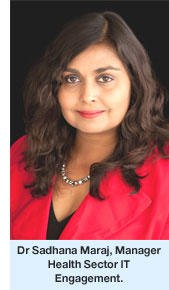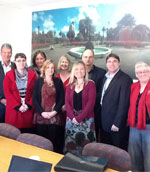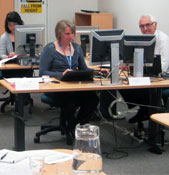|
|
 Health is coming of age in terms of person-centred, integrated systems, just as financial services did over the last decade. We need to develop the leadership and programme capability to meet the challenge. Health is coming of age in terms of person-centred, integrated systems, just as financial services did over the last decade. We need to develop the leadership and programme capability to meet the challenge.
Now we have our direction, goals and priorities clear, the next step is ensuring the health sector has the capability to design, deliver and operate the new national and regional solutions. We’re committed to lifting the professionalism of health IT leadership in New Zealand.
The National Health IT Board (NHITB) has recognised that boosting the capacity of IT teams is paramount to achieving the eHealth vision. Building on the regional implementation plans and the call for a single IT Programme Director for each region reporting to a regional governance board, the board wishes to signal our expectations for IT capacity.
The NHITB will work with the sector and Health Benefits Limited to define a set of expectations for regional and national IT teams and will be operating an assessment process by mid-2012. The idea is that if a regional IT organisation cannot reach the NHITB’s base level expectations, they will not have regional and national projects endorsed.
The NHITB will also be promoting the health sector as a great place for IT professionals to work.
I was at the annual Health Informatics New Zealand (HINZ) conference last week. The event was once again a highlight of the health IT sector's calendar and an important forum for developing our leaders and learning from overseas guests. We'll be reporting back on the conference in detail in the next issue of this newsletter but we have got the Clinicians' Challenge 2011 results for you in the following article.
Graeme Osborne
Director
National Health IT Board
Back to top.
|
|
|
A Waitemata DHB intensive care specialist's proposal for a language interpreter system has won the 2011 Clinician's Challenge.
Janet Liang, from North Shore Hospital, had the best clinical case in the challenge, and her award was announced at the recent HINZ conference in Auckland.
Clinicians entered the challenge by outlining a work-related problem that the innovative use of information technology could help solve. Health IT vendors were then asked to come up with a solution to the three cases chosen as finalists. There were 56 entries from clinicians this year.
The clinical case runners up were:
eNotifications of legally reportable conditions to Medical Officers of Health - entered by a group of clinicians and presented by Nicholas Jones, a Public Health Physician at Hawke’s Bay District Health Board.
An electronic early warning scoring system to alert staff to patients who are deteriorating - entered by Capital and Coast DHB Intensive Care Specialist Alex Psirides and presented by Nurse Specialist Anne Pedersen.
Healthlink, Kinross Group and Maxsys came up with the winning vendor concept, a solution to eNotify legally reportable conditions to Medical Officers of Health. (As the clinician cases and vendor responses are judged separately, the winners for each section do not necessarily match).
The vendor runners up were iSoft for the early warning scoring system. No vendor proposals were received for a language interpreter.
This year's Clinicians' Challenge prizes included international study and field trip opportunities.
The challenge is run by the National Health IT Board (NHITB), Health Informatics New Zealand (HINZ), and the New Zealand Health IT Cluster. The Ministry of Science and Innovation also provided sponsorship towards the vendor prize.
The challenge aims to promote the use of information technology in health. We want to encourage more clinicians to become interested in technology, we want vendors to further develop their understanding of clinical requirements and we want IT systems developed that help us to work smarter and improve patient outcomes.
Back to top.
|
|
|
 It's not everyday you’d describe a meeting as filled with excitement and enthusiasm – but our recent eReferrals workshop was a welcome exception!
It's not everyday you’d describe a meeting as filled with excitement and enthusiasm – but our recent eReferrals workshop was a welcome exception!
Representatives from Canterbury, Auckland, Northland and Hutt District Health Boards (DHBs) attended the workshop in Wellington following The National Institute for Health Innovation’s evaluations of their eReferral projects. David Kerr from Canterbury DHB - who is also executive lead for the NICLG eReferrals workstream - chaired the workshop.
We wanted the DHBs to share experiences and then establish common ground and a way forward. Everyone wanted to work together to ensure they were going in the same direction. All regions acknowledged the importance of using clinical panels and proactively engaging clinicians in all aspects of eReferral projects.
The role of clinicians in taking ownership and supporting progress throughout the development phase is critical to the success of eReferral implementations.
Workshop participants want to share the lessons they have learnt with other DHBs who are just getting started on eReferrals projects, including:
- how you can work with what’s out there already.
- what systems are available.
- what's tried and true.
- who needs to be involved and when.
- the role of information standards.
We agreed to work together on developing guidelines, set up an action plan for future work and work with Health Information Standards Organisation (HISO) to develop a national standard for eReferrals.
DHBs need to take a regional approach to eReferrals but we need some national consistency within these regional approaches.
The National Health IT Board will coordinate this work going forward and provide opportunities for other DHBs to become involved.
The National Clinical Leadership Group has also picked up eReferrals as a work stream and will be clarifying the definition and scope of eReferrals, developing a short, medium and long-term vision and integrating eReferrals as part of clinical pathways.
Back to top.
|
|
|
|
|
|
|
|
|
One Portal,
One Password,
One Patient Record
For every Clinician
At every Facility
Across the Central Region
|
With the sign-off of the business case for the Central Region Information Systems Plan (CRISP), six DHBs are now working towards a single regional system for managing patient information.
NHITB Director Graeme Osborne says CRISP is more than just another IT programme – it’s a major step towards improved patient care and safety.
“This is the beginning of a regional platform and the consolidation of systems, to align with the National Health IT Plan.
“Technology systems will ‘talk’ to each other, so information can be shared across the region. Clinicians will be able to view all relevant patient information, improving patient care.”
Mr Osborne says regional information delivery means secondary care can be provided by hospitals working together as a regional health network with each focusing on what they can best provide.
“Taking a regional approach can lead to more efficient use of high-cost facilities and equipment, and better use of clinical and support staff. As well, the move to regionally based information systems will enable greater peer support for health professionals and better supervision and training opportunities.”
CRISP Strategy Lead and MidCentral DHB IS Strategy and Planning Manager Brian Woolley says CRISP is now moving into the programme initiation phase.
“We are undertaking detailed activity planning for the next six to nine months. We will be developing an implementation plan and detailed timeline, confirming the project scope and costs, and considering communications and change management as well as quality and resourcing.”
He says a ‘gateway review’ of the project will be undertaken by the State Services Commission in February.
A master agreement between the DHBs is being developed.
“This will be a legal agreement on how CRISP will jointly operate – including agreeing funding and ownership issues.”
CRISP has many advantages for clinicians.
“Up-to-date patient information will be available quickly and consistently, and clinicians will have a single view of clinical information – they will no longer need to use several different information systems,” says Brian Woolley.
A new patient administration system will see improvements in data quality and patient flow throughout the region’s hospitals.
"For example, sharing the same radiology and picture archiving systems means clinicians will have simultaneous access to radiological images and reports from all six DHBs. Radiologists could work across DHBs to report on images and provide peer review or after hours support where required."
CRISP will also benefit patients.
"Having timely access to information gives clinicians a better basis for making decisions. And better information systems mean there’s less chance of medication or treatment errors.
"Ultimately, patients will receive better care."
Back to top.
|
|
|
|
|
|
|
|
|
|
|
| |

A quick glance at the CV of Dr Peter Gow – head of the Department of Rheumatology at Middlemore Hospital and Honorary Clinical Associate Professor at the South Auckland Clinical School – shows he has enough happening to fill several full-time jobs.
So why does he also carve out time to chair the NHITB’s National Information Clinical Leadership Group (NICLG)?
Dr Gow says it’s because he’s a passionate believer in clinicians and IT people partnering together from the very start of a project to create systems that work for everyone to the ultimate benefit of patients.
The alternative for too many organisations is that clinicians are presented with an IT solution that doesn’t meet their needs but they end up having to live with it, he says.
"You need that partnership from the beginning so the solution is more robust."
Successful IT change also requires a change in the way clinicians behave, and this message is much more likely to be received from a fellow clinician, says Peter Gow.
"With IT projects, people assume that if it is a good program and easy to use the change will just happen. But clinicians are fairly conservative and work under time pressure so even a minor change can be quite significant."
Dr Gow enjoys working with both clinical colleagues and the consumer representative on NICLG as they engage on a wide range of clinical process and information solutions.
"The members are there because of the diversity of their skills and opinions, they’re not there just because of their professional group; they bring a broader perspective. Having a consumer representative on NICLG, Ernie Newman, is useful too as it anchors the fact that all this work is for the benefit of the patients."
Dr Gow is personally involved in "piloting the practicalities" of the shared care programme, which is contributing to better care for patients with gout in Counties Manukau DHB and primary care.
He also packs a lot into his spare time, enjoying travelling, photography and tramping, especially on South Island tracks. “We are very fortunate to live in such a beautiful country."
Back to top.
|
|
| |
NICLG (pronounced 'Nickle') is made up of members from a variety of professional bodies and colleges providing leadership and support for clinicians in New Zealand. It provides clinical leadership input into the National Health IT Plan and has input into a range of clinical process and information solutions.
NICLG most recently met on 1 November in Wellington. A number of projects were discussed, including a national acute coronary syndrome registry and quality improvement project, prioritisation tools for scheduled services, the Health Identity Project, and the eMedication and eReferrals programmes.
For further information, see the November NICLG update.
Back to top.
|
|
|
|
|
|
|
|
|
|
 |
|
The Evaluation Panel.
|
The Shared Maternity Record of Care will introduce a new way for those involved in maternity care to share and transfer information during pregnancy, childbirth and until the baby is six-weeks-old.
The project is about improving quality, safety and information sharing, says project manager John Tolchard. It sits under the NHITB’s National Shared Care Plan Programme.
“The record of care is an electronic summary of the information gathered by health professionals, containing essential information and data captured through the maternity journey.”
With the woman’s permission, key summary information in her maternity record of care can be shared between her, her lead maternity carer, and other relevant health professionals – such as her GP and medical specialists -- so that when care decisions are made they are based on all the information.
"For example, if a pregnant woman has a car accident and goes to ED, doctors can access her recent tests, what medication she is on, a summary of her pregnancy history and find out who her lead maternity carer is.
"Health professionals won’t have to make decisions based on incomplete information and the woman won’t have to have tests repeated."
The project is taking place in several stages. Stage one – the implementation planning study – is underway and is gathering information so a solution can be developed.
Software vendor Orion Health and key stakeholders met recently. The meeting included representatives from the DHBs involved in the pilots; the Colleges of Midwives, Obstetricians and Gynaecologists, and GPs; consumer representatives; the Ministry of Health and non-government organisations. Further information gathering will take place with functionality and subject matter experts.
Mr Tolchard says getting DHBs and the wider workforce involved early is critical to the project’s success.
"This is very much a community project and we need DHBs to work with their local communities and reflect their requirements. The Shared Maternity Record of Care begins when a woman first attends for care in pregnancy – meaning much of the collecting and sharing of information takes place in the community setting.
"A clinical reference group has been appointed to work on addressing information gaps and will consult with a wider stakeholder group."
When the implementation planning stage ends, a report will further define the project’s scope and detail the next phases – the build, proof of concept and pilot.
Pilots of the Shared Maternity Record of Care will start at Auckland and Canterbury DHBs in March or April next year. Mr Tolchard says they plan to have a workable solution by then, but cautions it won’t be perfect from day one.
"We will focus on the ‘must haves’ rather then the ‘nice to haves’ at first, but the solution will evolve during the proof of concept and pilot phases."
These later phases will focus on making sure information flows are working and information can be securely shared between providers and participating women. They will run for at least 90 days. An independent evaluation will then make recommendations about the planned national roll out.
Other projects in the National Shared Care Programme include an Auckland region pilot for patients with long-term conditions and a project accessing patients’ records for emergency care in Canterbury.
Back to top.
|
|
|
|
|
|
|
|
|
|
|
The HINZ conference was held in Auckland from Wednesday 23 to Friday 25 November 2011.
The conference has been an annual highlight for the health information technology community for almost a decade.
Keynote speakers included Dr David, until recently President Obama’s National Coordinator for health IT, and Andrew Howard, the Australian National e-Health Transition Agency’s Chief Architect.
For more information see www.hinz.org.nz
Back to top.
|
|
|
|
|
|
|
|
|
|
|
|
|
|
|
HISO Update
 Staff at METeOR training
Staff at METeOR training
Signing a contract with the 'Australian Institute of Health and Welfare' (AIHW) over the METeOR repository is a milestone achievement, says Health Information Solutions and Standards Manager Kathy Farndon.
The Ministry of Health has become a registration authority for METeOR, a meta-data electronic online repository. METeOR will be used in many IT Health Board projects.
Experts from AIHW visited New Zealand recently to train Ministry staff to use METeOR.
HISO (2010) has endorsed the use of METeOR for the health and disability sector in New Zealand.
Kathy Farndon says a meta-data registry contains the agreed definition and description of the structure, meaning and usage of specific data.
“It enables users to search and identify standard items and definitions and use information confidently. This has many benefits as it improves the quality, relevance, consistency and availability of national information about the health of New Zealanders.”
Other benefits to more accessible metadata standards include:
| • |
consistency of content and definition |
|
|
| • |
avoiding duplication and diversity of solutions |
|
|
| • |
reducing the cost of data development. |
|
|
Kathy says the initial focus will be on core and common data-sets, but METeOR will be rolled out more widely when there are fully qualified and accredited users in New Zealand.
Back to top.
|
|
|
|
|
|
|
|
|
|
|
|
No matter who you are or what you do, some information you work with – for example names and addresses – is “core and common” and should be stored and handled in a standard, secure and consistent manner, says Principal Advisor Ted Christiansen.
Ted is helping prepare an initial HISO Standard for core and common information, with the first draft available for discussion early next year.
The Standard is intended to cover four areas:
| • |
general administrative details – basic demographic information like a date, time, name and address |
|
|
| • |
person demographics – for example title, ethnicity and next of kin |
|
|
| • |
historic medical information – relevant information from past experiences |
|
|
| • |
current medical information – why the patient is here now |
The Standard for core and common information is a form of metadata – data about data – and will be included in the METeOR data repository tool.
Back to top. |
|
|
|
|
|
|
|
|
Up to 500 NGOs and all DHBs are being surveyed to find out how well the Programme for the Integration of Mental Health Data (PRIMHD) Standard is working for them as part of the review process. PRIMHD is a Ministry of Health project that created a single collection of national mental health information.
Rosemary Jarmey, from Health Information Solutions and Standards, is running a survey as part of the revised HISO Standards review process.
“We want to find out where the gaps are and how we can make the Standard more useful.”
She emphasises that the review focuses on the Standard and whether it is meeting its purpose, rather than a review of PRIMHD overall.
“Small technical issues such as missing codes can be fixed up along the way but any major technical upgrades or strategic issues are outside our scope.”
The survey closed on 27 October and the response has been very encouraging.
For more information please contact: Rosemary_Jarmey@moh.govt.nz
Back to top. |
|
|
For some years, the cancer sector has identified a need for nationally endorsed data standards. Improved health outcomes and more cost-effective care are the expected benefits of more consistent and efficient management of health information.
The National Cancer Core Data Business Process, Data Definitions, and Messaging Standards have been developed to provide a consistent approach to the collection and storage of core cancer data in New Zealand.
The suite of standards is now available at
www.ithealthboard.health.nz
Back to top. |
|
|
The two not-for-profit international organisations that are the main players in health terminology met recently for a three-day face-to-face meeting in Singapore.
The organisations were looking at ways to work together better, with the aim of harmonising medical device terminology into standardised clinical terminology (SNOMED CT).
The meeting was between a core team of senior representatives of the International Health Terminology Standards Development Organisation (IHTSDO), the provider of SNOMED CT, and the Global Medical Device Nomenclature (GMDN) Agency responsible for the international naming system for medical devices.
Kathy Farndon, who is the New Zealand representative on the IHTSDO management board, said the intense three-day meeting followed weekly teleconferences that have been taking place since June.
“It was a very useful meeting. There were discussions around the introduction of a more comprehensive and harmonised clinical terminology as well as the need for greater utility and access to both terminologies. Opportunities to improve organisational efficiencies were also considered.”
Each organisation is now considering:
| • |
concluding an agreement on the incorporation of the GMDN terminology into SNOMED CT for clinical evaluation purposes by the end of the year |
|
|
| • |
continuing to seek an even closer alliance and opportunities to reduce costs further. |
Back to top.
|
|
|
|
|
|
|